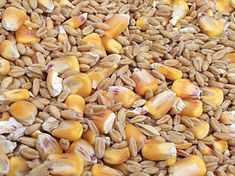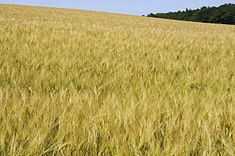Alqueire
The alqueire was a unit of measure for the distribution of productive land in Brazil and Portugal. The alqueire was an indication of land used, based on its capacity, determined by the quantity/volume extracted from the land, and varied between 10 and 22 litres.[1] It was generally used for grain.
History


The alqueire entered the Portuguese language around the 12th century.[2] It was used by the Arabs to refer originally to the bags carried by pack-animals, to transport grain.[2] With time, the word began to signify, by analogy, the quantity of grain that could be carried in the lateral satchels of the pack animals.[2]
In the beginning, therefore, the measure was a capacity by solids or liquids.[2] But, alqueire turned into a measure of area, by analogy, because one alqueire corresponded to the area necessary to plant the quantity of grain that would normally be carried in the satchels.[2]
The alqueire, equivalent to Roman (8.733 litres), was originally adopted by Afonso Henriques around 1179.[3] From the 12th to 13th century, the area of Sangalhos, along with Horta (Tamengos), Recardães and Óis da Ribeira, were selected by the monarch to be the test areas for the implementation of the alqueire unit of measure, in the distribution and productivity of lands.[3] For a time, the archbishopric of Vouga and bishopric of Porto, the Henriquino alqueire began to be referred to as the Sangalhos, sangalhês or sangalho.[3]
Several regional versions then began to propagate, owing to issues of arability that then existed. In the time of the Portuguese Discoveries, the settlers of Brazil, adopted the alqueire as a common unit of measure, with variations propagating throughout their territory:
| alqueire paulista | 2.42 hectares |
| alqueire mineiro or goiano | 4.84 hectares |
| alqueire baiano | 9.69 hectares |
| alqueire do norte | 2.72 hectares |
But, even as the unit of measure began to fall into disuse, following the reforms during the reign of King Manuel I of Portugal's (16th century), the settlement of the Portuguese colonies, such as Brazil and the Azores allowed the perpetuation of the measure.
Even until the 20th century, in conversations with local Azorean seniors, many would refer to comparable situations: "minha terra produziu 40 alqueires de milho por alqueire de terra" (my land produced 40 alqueires of corn per alqueire of land).[1] In the Azores, lands were distributed to the settlers who explored and expanded the territory; the Crown provided guarantees that who could explore and expand Portuguese patrimony would benefit from their largesse.[1] It was in the moio and alqueire that many of the rural property-owners obtained their honorific titles.[1]
See also
References
- ↑ 1.0 1.1 1.2 1.3 Almeida e Sousa, João Nuno (31 July 2011). "Alqueires, palmos e varas…pequenas e grandes!" (in Portuguese). Ponta Delgada (Azores), Portugal: :ILIHAS. Retrieved 4 April 2013.
- ↑ 2.0 2.1 2.2 2.3 2.4 Azevedo, Israel Belo de (4 May 2010). "BOM DIA: a história de duas palavras" (in Portuguese). Prazer da Palavra. Retrieved 4 April 2013.
- ↑ 3.0 3.1 3.2 Junta Freguesia, ed. (2011). "O alqueire de Sangalhos" (in Portuguese). Sangalhos (Anadia), Portugal: Junta Freguesia de Sangalhos. Retrieved 4 April 2013.